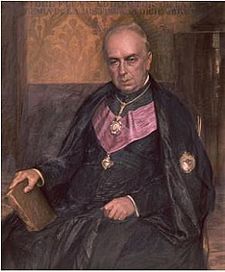Fidel Fita facts for kids
Fidel Fita Colomé was a Spanish expert in old civilizations, languages, and history. He was born on December 31, 1835, in Arenys de Mar, a town in Spain, and passed away on January 13, 1918, in Madrid. He spent his life studying ancient writings, old buildings, and historical events.
Contents
Fidel Fita's Early Life and Studies
Fidel Fita grew up in a family that was becoming more well-off. When he was ten, he went to Barcelona to study grammar. At fifteen, in 1850, he joined the Jesuit order, a group of Catholic priests and brothers. He studied at different Jesuit schools, even one in Nivelles, Belgium, where he learned about public speaking. In 1853, he went to Sanctuary of Loyola to become a teacher of humanities (subjects like literature and philosophy) and Ancient Greek.
Teaching and Discovering History
During a time of political change in Spain in 1854, Fidel Fita had to leave the country and go to France. He came back in 1857 and started teaching Latin and French at a school in Carrión de los Condes. From 1860 to 1866, he lived in León. There, he taught theology (the study of religion) and began his own research into archaeology (the study of human history through digging up old things), history, and epigraphy (the study of ancient inscriptions).
His work led him to become the Vice-President of the "Comisión de Monumentos de León," a group that looked after historical sites. Here, he met an architect named Eduardo Saavedra, and they became lifelong friends and colleagues. During these years, Fidel Fita worked hard to find signs of the ancient Roman presence in the León area.
Exile and New Discoveries
In 1866, his Jesuit order moved him back to Catalonia. However, just two years later, in 1868, he was forced to leave Spain again because of another major political change called the "Glorious Revolution". He went back to France and did not return until 1870. After living in a few different places, he settled in Bañolas.
This time, he focused on finding and understanding old Hebrew writings in the Province of Girona. He also wrote letters to another archaeologist, Juan de Dios de la Rada, who was studying mysterious sculptures found near Cerro de los Santos.
Becoming a Leading Historian
In 1877, Fidel Fita was chosen to be an Academician at the Real Academia de la Historia (Royal Academy of History). This is a very important group of experts in Spain. He moved to Madrid, where he lived for more than thirty years.
He wrote over 700 articles for the Academy's Bulletin, which is like a special magazine for historians. About a third of these articles were about epigraphy, his favorite subject. Many of the world's top experts in epigraphy were his friends or people he knew. One important friend was Emil Hübner, who was working on a big collection of Latin inscriptions called the Corpus Inscriptionum Latinarum. Fidel Fita helped him a lot by providing information for this huge project.
In 1912, after the death of Marcelino Menéndez Pelayo, Fidel Fita became the Director of the Real Academia de la Historia. He held this important position until he passed away.
See also
 In Spanish: Fidel Fita para niños
In Spanish: Fidel Fita para niños


